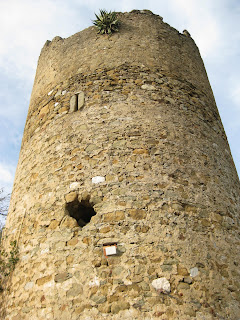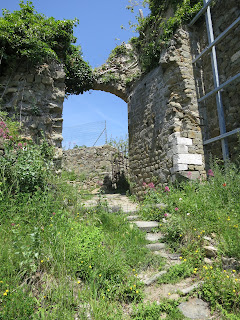Walk The Ruins of Carrara'sMoneta Castle
 |
| Forest view on the way to Moneta Castle. |
 |
| Moneta Castle, the Apuan Alps, and Carrara marble quarries. |
 |
| View from the Castle of vineyards and the Carrara plain. |
 |
| Castle Moneta. Defensive wall tower. |
The 'rustic villa' of the Roman Monaii family was established at roughly the same time as the Roman empire began the city of Luni in 177 B.C. This strategic site was previously fortified by the local Ligurian tribe, the Apuani. The location was convenient to the ancient route called the Via del Sale, used for salt and other trading toward Lunigiana and the interior. This area was then one of the frontiers of the Roman empire, as Roman expansion met the fierce Ligurian tribes of the coastal mountains. The conflicts with the Ligurians would last for over 300 years, and included a battle where 4,000 Roman legionnaires were killed. In another episode, 47,000 Ligurians were deported to the south. The fortified villa became part of a defensive ring around Luni which included the present towns of Nicola and Ortonuovo and Avenza.
The fortified villa was transformed into a castle by the Byzantines while still a part of the Luni sphere in the 6th century. Subsequently, the Lombards (Longobards) took over in 643 AD, then Charlemagne's Franks in the 9th century. In the 10th and 11th centuries, while under the control of the Bishop/Counts of Luni, the castle was further fortified to resist the incursions of Normans and Arabs whose attacks finally finished off Luni.
Via Francigena. The Castle of Moneta was located on the medieval route known as the Via Pedemontana, (the foothill route) which led up and down the peninsula and was used to minimize the dangers and malaria of the coastal areas. Thus it was a stopping point for pilgrims making the pilgrimage between Rome, Canterbury, Santiago, and other holy sites, known today as the Via Francigena. It's easy to forget that there was never a single path called the Francigena. The route varied according to weather, hospices, brigands, rumor, and fad. The castle chapel threshold at Moneta shows the wear of centuries of feet, but also the welcome symbol for pilgrims in the cross carved in the stone (see photo).
 |
| The well-worn threshold includes a carved cross welcoming pilgrims. Moneta Castle, Carrara, Italy |
Year 1455: The Maximum and Last Splendor. Many of the castle features that are evident today are the product of a large renovation carried out by one Spinetta di Campo Fregoso. Signore Campo Fregoso became the owner – by 1447 - of Moneta Castle as well as of Carrara, Avenza, and Castelpoggio Castles after the withdrawal of the Visconti of Pavia. The rebuilding lasted until 1455.
The renewed castle featured a larger borgo (castle town) below and around the summit surrounded by an elliptical wall. An additional defensive wall with robust round towers encircled the castle/borgo complex which now comprised half the hill. The castle's ancient square defensive tower became the campanile of a new castle church, and this is the high square tower still standing today. The dominant feature became a new imposing Rocca (castle keep) on the west side of the borgo. Three sides of the fortress were unscaleable sheer walls and the fourth faced the borgo with a defensive ditch crossed by a drawbridge and protected by an imposing tower. Additionally, huge underground cisterns were added, fed by local springs, to improve village life and add to the castle's defensive resources.
 |
| Ruins of the gateway into Moneta Castle |
In 1476, the castle passed to Jacopo Malaspina of Fosdinovo, Marchese of Massa after the death of Spinetta di Campo Fregoso. Under the Malaspina, the castle began a long decline, never to regain importance. Military garrisons were stationed here for centuries, however, until the time of Napoleon. The castle was abandoned by 1804, and the property is now owned by the city of Carrara. There have been numerous restoration proposals over the last few decades, but still the ivy grows.
Getting There
 |
| V. Silicani turn at V. 20 Settembre |
Follow Via Silicani (which becomes Via Agricola) about 1.5 Km, as it becomes progressively narrower. Above, on a hill to the right, you can see the Castle ruins. At the second hairpin turn, you'll see a small sign indicating the path - see the photo below. Park here for the full walk described, or if you drive up the narrow road and park at a wide spot where the road turns to gravel, you'll be 1/3 of the way.
One can also drive close to the Castle ruins using Via Moneta, see the Google map.
Ameglia Montemarcello San Terenzo Panegacci Pontremoli Filattiera Copyright 2012 Mike Mazzaschi, Martha Bates www.apathtolunch.com. All Rights Reserved. Aulla Fivizzano Castelnuovo Magra This article appeared on www.apathtolunch.com and has not been authorized elsewhere. Cinque Terre Lerici Liguria Arcola Caniparola Massa Luni Testaroli Filetto Comano Mulazzo Zeri Sarzana Alpi Apuane Serra La Spezia
More Info
 |
| Beginning of path is signed. |
May 16. Every year around this date, the inhabitants of Fossola honor their patron, San Isidoro, with a procession to the Castle in medieval dress where a mass is celebrated. Fossola Procession Video Check the local listings before setting out.
Panorama. If you continue up the auto road about 4km., now called Via Nuova di Fontia, to the frazione of Fontia, a very sharp left turn to the Santa Lucia Church leads to a stupendous panorama of the Versilia / Lunigiana coastal plain. The road has a sign indicating that it dead ends in 1500m.
Castles and Fortifications Wikipedia is at its best providing complete castle information with these two entries.
Lunch
Osteria Gloria Located near the Carrara Autostrada entrance, this is an enjoyable restaurant for lunch. It doesn't get more Italian than this. Stone industry executives, port workers, truckers, and pensionati arrive for good food at a good price. The menu is verbal, and they don't get many tourists, but it's friendly if a bit hurried. We can attest that the Insalata di Polpi, the Seafood Risotto, and the Seppie con Patate are good, and our bill for those three plus water and wine was 24 Euro! (11/2010) It's listed in Slow Food's Osterie d'Italia as it deserves to be, (Via Covetta, 92. tel. 0585 53876 closed Sundays and holidays. Via Corvetta runs parallel to the autostrada on the Alpi side. ). Read our review: The Pleasure of a Business Lunch
Written by Martha
